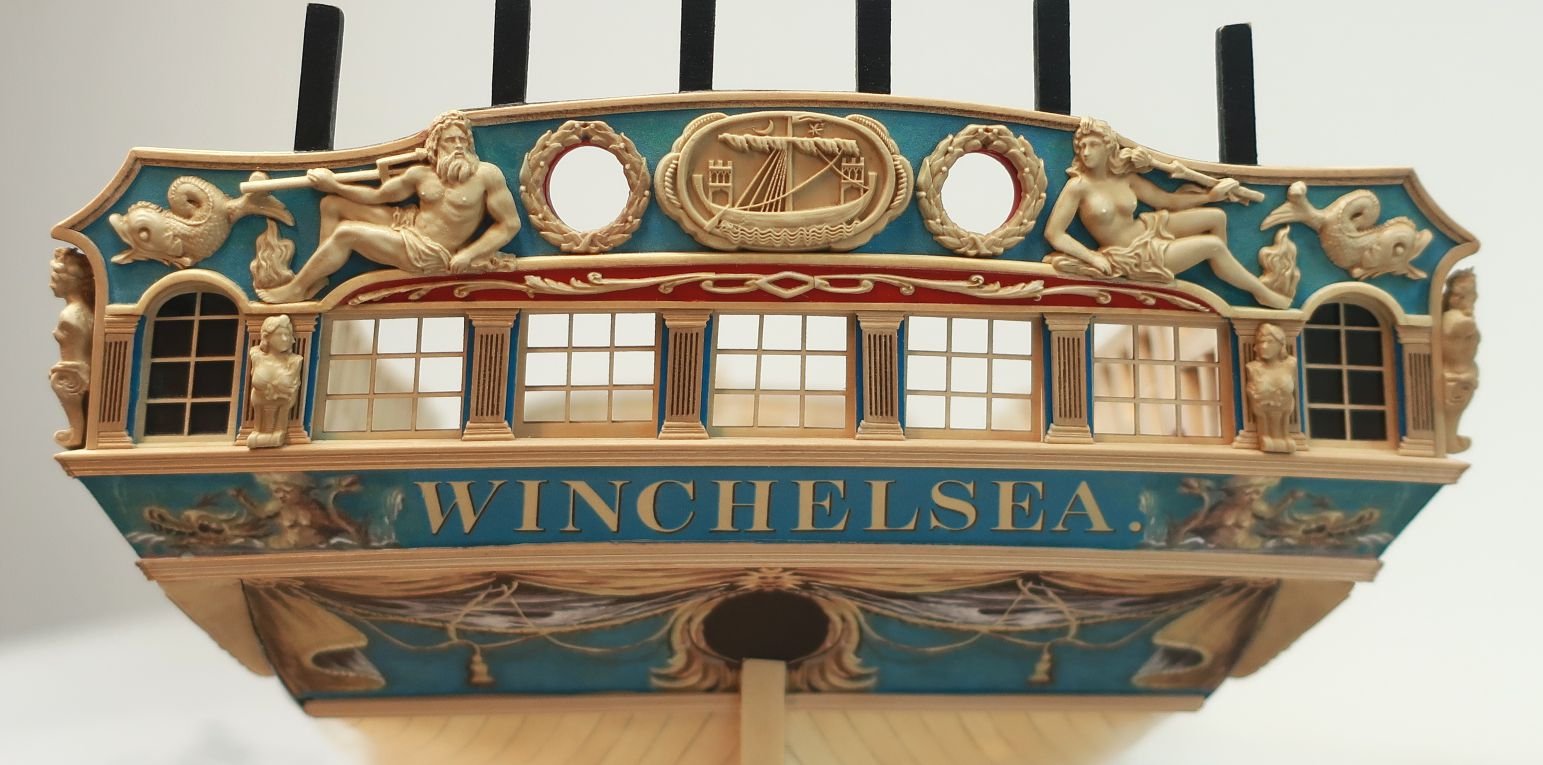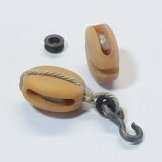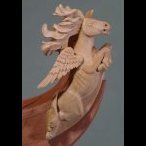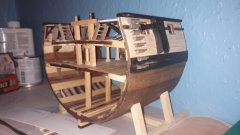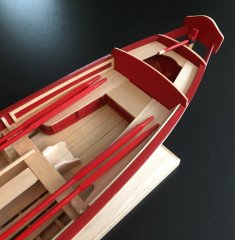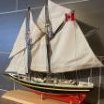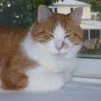-
Posts
9,391 -
Joined
-
Last visited
Reputation Activity
-
 Chuck got a reaction from Canute in Syren Ship Model Company News, Updates and Info.....(part 2)
Chuck got a reaction from Canute in Syren Ship Model Company News, Updates and Info.....(part 2)
They are available!!!
-
 Chuck got a reaction from Ronald-V in Syren Ship Model Company News, Updates and Info.....(part 2)
Chuck got a reaction from Ronald-V in Syren Ship Model Company News, Updates and Info.....(part 2)
They are available!!!
-
 Chuck reacted to westwood in HMS Portland 1770 by westwood - Portland Scale Ship Co. - 1:48 - 50 gun 4th rate
Chuck reacted to westwood in HMS Portland 1770 by westwood - Portland Scale Ship Co. - 1:48 - 50 gun 4th rate
ready to continue...
-
 Chuck reacted to Blue Ensign in HMS Harpy 1796 by Blue Ensign – Vanguard Models - 1:64 scale
Chuck reacted to Blue Ensign in HMS Harpy 1796 by Blue Ensign – Vanguard Models - 1:64 scale
Post 95
Main stay. (Part 2)
The lower end of the stays have hearts turned in.
I am using Syren Resin versions, (6mm) for the Main Stay and (5mm) for the Preventer.
The kit provided deadeyes for this purpose are easier to fit than hearts and lanyards, but were an old fashioned option by the time of Harpy.
4901a
It is easier to fit the Preventer stay and collar with the Main stay and Fore shrouds out of the way.
I had fitted the Preventer stay at this point but found I had fed it incorrectly through the mast top.
Annoying when you have spent time doing tiny seizing and fitting of lanyards, but I couldn’t let it stand.
4895a
4897a
4898a
Lashing of the Main stay I used Syren 0.45mm line.
For the collar 0.88 mm line served with 0.1mm line was used. The tricky part of the collar is forming the eye in one short leg.
Main Preventer stay
4904a
Stropping the Preventer stay heart.
4905a
4908a
0.3mm line used for the Lanyard.
4909a
4910a
I can now attend to the Fore Shrouds.
B.E.
27/06/2025
-
 Chuck got a reaction from Trussben in Syren Ship Model Company News, Updates and Info.....(part 2)
Chuck got a reaction from Trussben in Syren Ship Model Company News, Updates and Info.....(part 2)
Another new item will soon be in stock. I had run out of my old swivel guns. Those were cast in the traditional way and not 3D printed. They has casting marks etc. So now that I ran out of them I figured I would do a redesign. Here are photos of the new 3D printed swivel guns. Two pieces. The yoke is flexible-ish. This enables some manipulation to just slide the yoke into position from the bottom of the barrel and into the the holes. Once you get one done the others will be easy.
I am pretty thrilled with these results because as some of you may be aware, black 3d printing resin is somewhat less than desirable. The results often look too much like plastic or are too shiny and doesnt really show details well. So I have conducted many tests yet again on my resin of choice. The black finish is not to stark a black or but nice and warm and on the touch of a dark warm gray. Very dark. The material is also matte or barely satin. So its a win-win. I tried very hard to make these look like blackened brass or brushed metal which I think I achieved pretty darn close actually. This batch is 13/16" long not including the handle. (What is used for the Winnie).
Use these straight out of the bag.
I should have some more sizes and these will be fully stocked in a few days.
-
 Chuck got a reaction from Edwardkenway in Syren Ship Model Company News, Updates and Info.....(part 2)
Chuck got a reaction from Edwardkenway in Syren Ship Model Company News, Updates and Info.....(part 2)
Another new item will soon be in stock. I had run out of my old swivel guns. Those were cast in the traditional way and not 3D printed. They has casting marks etc. So now that I ran out of them I figured I would do a redesign. Here are photos of the new 3D printed swivel guns. Two pieces. The yoke is flexible-ish. This enables some manipulation to just slide the yoke into position from the bottom of the barrel and into the the holes. Once you get one done the others will be easy.
I am pretty thrilled with these results because as some of you may be aware, black 3d printing resin is somewhat less than desirable. The results often look too much like plastic or are too shiny and doesnt really show details well. So I have conducted many tests yet again on my resin of choice. The black finish is not to stark a black or but nice and warm and on the touch of a dark warm gray. Very dark. The material is also matte or barely satin. So its a win-win. I tried very hard to make these look like blackened brass or brushed metal which I think I achieved pretty darn close actually. This batch is 13/16" long not including the handle. (What is used for the Winnie).
Use these straight out of the bag.
I should have some more sizes and these will be fully stocked in a few days.
-
 Chuck got a reaction from Tigersteve in Syren Ship Model Company News, Updates and Info.....(part 2)
Chuck got a reaction from Tigersteve in Syren Ship Model Company News, Updates and Info.....(part 2)
Another new item will soon be in stock. I had run out of my old swivel guns. Those were cast in the traditional way and not 3D printed. They has casting marks etc. So now that I ran out of them I figured I would do a redesign. Here are photos of the new 3D printed swivel guns. Two pieces. The yoke is flexible-ish. This enables some manipulation to just slide the yoke into position from the bottom of the barrel and into the the holes. Once you get one done the others will be easy.
I am pretty thrilled with these results because as some of you may be aware, black 3d printing resin is somewhat less than desirable. The results often look too much like plastic or are too shiny and doesnt really show details well. So I have conducted many tests yet again on my resin of choice. The black finish is not to stark a black or but nice and warm and on the touch of a dark warm gray. Very dark. The material is also matte or barely satin. So its a win-win. I tried very hard to make these look like blackened brass or brushed metal which I think I achieved pretty darn close actually. This batch is 13/16" long not including the handle. (What is used for the Winnie).
Use these straight out of the bag.
I should have some more sizes and these will be fully stocked in a few days.
-
 Chuck got a reaction from Pitan in Syren Ship Model Company News, Updates and Info.....(part 2)
Chuck got a reaction from Pitan in Syren Ship Model Company News, Updates and Info.....(part 2)
Another new item will soon be in stock. I had run out of my old swivel guns. Those were cast in the traditional way and not 3D printed. They has casting marks etc. So now that I ran out of them I figured I would do a redesign. Here are photos of the new 3D printed swivel guns. Two pieces. The yoke is flexible-ish. This enables some manipulation to just slide the yoke into position from the bottom of the barrel and into the the holes. Once you get one done the others will be easy.
I am pretty thrilled with these results because as some of you may be aware, black 3d printing resin is somewhat less than desirable. The results often look too much like plastic or are too shiny and doesnt really show details well. So I have conducted many tests yet again on my resin of choice. The black finish is not to stark a black or but nice and warm and on the touch of a dark warm gray. Very dark. The material is also matte or barely satin. So its a win-win. I tried very hard to make these look like blackened brass or brushed metal which I think I achieved pretty darn close actually. This batch is 13/16" long not including the handle. (What is used for the Winnie).
Use these straight out of the bag.
I should have some more sizes and these will be fully stocked in a few days.
-
 Chuck got a reaction from Archi in Syren Ship Model Company News, Updates and Info.....(part 2)
Chuck got a reaction from Archi in Syren Ship Model Company News, Updates and Info.....(part 2)
Another new item will soon be in stock. I had run out of my old swivel guns. Those were cast in the traditional way and not 3D printed. They has casting marks etc. So now that I ran out of them I figured I would do a redesign. Here are photos of the new 3D printed swivel guns. Two pieces. The yoke is flexible-ish. This enables some manipulation to just slide the yoke into position from the bottom of the barrel and into the the holes. Once you get one done the others will be easy.
I am pretty thrilled with these results because as some of you may be aware, black 3d printing resin is somewhat less than desirable. The results often look too much like plastic or are too shiny and doesnt really show details well. So I have conducted many tests yet again on my resin of choice. The black finish is not to stark a black or but nice and warm and on the touch of a dark warm gray. Very dark. The material is also matte or barely satin. So its a win-win. I tried very hard to make these look like blackened brass or brushed metal which I think I achieved pretty darn close actually. This batch is 13/16" long not including the handle. (What is used for the Winnie).
Use these straight out of the bag.
I should have some more sizes and these will be fully stocked in a few days.
-
 Chuck got a reaction from Max Blackwood in Syren Ship Model Company News, Updates and Info.....(part 2)
Chuck got a reaction from Max Blackwood in Syren Ship Model Company News, Updates and Info.....(part 2)
Another new item will soon be in stock. I had run out of my old swivel guns. Those were cast in the traditional way and not 3D printed. They has casting marks etc. So now that I ran out of them I figured I would do a redesign. Here are photos of the new 3D printed swivel guns. Two pieces. The yoke is flexible-ish. This enables some manipulation to just slide the yoke into position from the bottom of the barrel and into the the holes. Once you get one done the others will be easy.
I am pretty thrilled with these results because as some of you may be aware, black 3d printing resin is somewhat less than desirable. The results often look too much like plastic or are too shiny and doesnt really show details well. So I have conducted many tests yet again on my resin of choice. The black finish is not to stark a black or but nice and warm and on the touch of a dark warm gray. Very dark. The material is also matte or barely satin. So its a win-win. I tried very hard to make these look like blackened brass or brushed metal which I think I achieved pretty darn close actually. This batch is 13/16" long not including the handle. (What is used for the Winnie).
Use these straight out of the bag.
I should have some more sizes and these will be fully stocked in a few days.
-
 Chuck reacted to Ronald-V in Syren Ship Model Company News, Updates and Info.....(part 2)
Chuck reacted to Ronald-V in Syren Ship Model Company News, Updates and Info.....(part 2)
Those look amazing!
-
 Chuck reacted to thibaultron in Syren Ship Model Company News, Updates and Info.....(part 2)
Chuck reacted to thibaultron in Syren Ship Model Company News, Updates and Info.....(part 2)
Once again you have brought us a wonderful product! You are a resin printing Guru!
-
 Chuck reacted to Edwardkenway in HMS Winchelsea 1764 by Edwardkenway- 1:48
Chuck reacted to Edwardkenway in HMS Winchelsea 1764 by Edwardkenway- 1:48
Hi all,
The second cabin bulkhead has been tested, tweaked and finally fitted. The door knobs caused me the biggest headache, as the ones Chuck supplies, I managed to break or lose most of them, so fashioned new ones from the offcuts of the cannon trunnions.
There are still only two beams glued in, as I daren't glue the others till I'm absolutely sure I can!!
It certainly gives Winnie a better look with these bulkheads fitted.thanks for your support.
I still have some little niggles to sort out, but work progresses slowly.
Cheers
-
 Chuck got a reaction from CiscoH in Syren Ship Model Company News, Updates and Info.....(part 2)
Chuck got a reaction from CiscoH in Syren Ship Model Company News, Updates and Info.....(part 2)
Another new item will soon be in stock. I had run out of my old swivel guns. Those were cast in the traditional way and not 3D printed. They has casting marks etc. So now that I ran out of them I figured I would do a redesign. Here are photos of the new 3D printed swivel guns. Two pieces. The yoke is flexible-ish. This enables some manipulation to just slide the yoke into position from the bottom of the barrel and into the the holes. Once you get one done the others will be easy.
I am pretty thrilled with these results because as some of you may be aware, black 3d printing resin is somewhat less than desirable. The results often look too much like plastic or are too shiny and doesnt really show details well. So I have conducted many tests yet again on my resin of choice. The black finish is not to stark a black or but nice and warm and on the touch of a dark warm gray. Very dark. The material is also matte or barely satin. So its a win-win. I tried very hard to make these look like blackened brass or brushed metal which I think I achieved pretty darn close actually. This batch is 13/16" long not including the handle. (What is used for the Winnie).
Use these straight out of the bag.
I should have some more sizes and these will be fully stocked in a few days.
-
 Chuck got a reaction from gjdale in Syren Ship Model Company News, Updates and Info.....(part 2)
Chuck got a reaction from gjdale in Syren Ship Model Company News, Updates and Info.....(part 2)
Another new item will soon be in stock. I had run out of my old swivel guns. Those were cast in the traditional way and not 3D printed. They has casting marks etc. So now that I ran out of them I figured I would do a redesign. Here are photos of the new 3D printed swivel guns. Two pieces. The yoke is flexible-ish. This enables some manipulation to just slide the yoke into position from the bottom of the barrel and into the the holes. Once you get one done the others will be easy.
I am pretty thrilled with these results because as some of you may be aware, black 3d printing resin is somewhat less than desirable. The results often look too much like plastic or are too shiny and doesnt really show details well. So I have conducted many tests yet again on my resin of choice. The black finish is not to stark a black or but nice and warm and on the touch of a dark warm gray. Very dark. The material is also matte or barely satin. So its a win-win. I tried very hard to make these look like blackened brass or brushed metal which I think I achieved pretty darn close actually. This batch is 13/16" long not including the handle. (What is used for the Winnie).
Use these straight out of the bag.
I should have some more sizes and these will be fully stocked in a few days.
-
 Chuck got a reaction from usedtosail in Syren Ship Model Company News, Updates and Info.....(part 2)
Chuck got a reaction from usedtosail in Syren Ship Model Company News, Updates and Info.....(part 2)
Another new item will soon be in stock. I had run out of my old swivel guns. Those were cast in the traditional way and not 3D printed. They has casting marks etc. So now that I ran out of them I figured I would do a redesign. Here are photos of the new 3D printed swivel guns. Two pieces. The yoke is flexible-ish. This enables some manipulation to just slide the yoke into position from the bottom of the barrel and into the the holes. Once you get one done the others will be easy.
I am pretty thrilled with these results because as some of you may be aware, black 3d printing resin is somewhat less than desirable. The results often look too much like plastic or are too shiny and doesnt really show details well. So I have conducted many tests yet again on my resin of choice. The black finish is not to stark a black or but nice and warm and on the touch of a dark warm gray. Very dark. The material is also matte or barely satin. So its a win-win. I tried very hard to make these look like blackened brass or brushed metal which I think I achieved pretty darn close actually. This batch is 13/16" long not including the handle. (What is used for the Winnie).
Use these straight out of the bag.
I should have some more sizes and these will be fully stocked in a few days.
-
 Chuck got a reaction from Rustyj in Syren Ship Model Company News, Updates and Info.....(part 2)
Chuck got a reaction from Rustyj in Syren Ship Model Company News, Updates and Info.....(part 2)
Another new item will soon be in stock. I had run out of my old swivel guns. Those were cast in the traditional way and not 3D printed. They has casting marks etc. So now that I ran out of them I figured I would do a redesign. Here are photos of the new 3D printed swivel guns. Two pieces. The yoke is flexible-ish. This enables some manipulation to just slide the yoke into position from the bottom of the barrel and into the the holes. Once you get one done the others will be easy.
I am pretty thrilled with these results because as some of you may be aware, black 3d printing resin is somewhat less than desirable. The results often look too much like plastic or are too shiny and doesnt really show details well. So I have conducted many tests yet again on my resin of choice. The black finish is not to stark a black or but nice and warm and on the touch of a dark warm gray. Very dark. The material is also matte or barely satin. So its a win-win. I tried very hard to make these look like blackened brass or brushed metal which I think I achieved pretty darn close actually. This batch is 13/16" long not including the handle. (What is used for the Winnie).
Use these straight out of the bag.
I should have some more sizes and these will be fully stocked in a few days.
-
 Chuck got a reaction from Nunnehi (Don) in Syren Ship Model Company News, Updates and Info.....(part 2)
Chuck got a reaction from Nunnehi (Don) in Syren Ship Model Company News, Updates and Info.....(part 2)
Another new item will soon be in stock. I had run out of my old swivel guns. Those were cast in the traditional way and not 3D printed. They has casting marks etc. So now that I ran out of them I figured I would do a redesign. Here are photos of the new 3D printed swivel guns. Two pieces. The yoke is flexible-ish. This enables some manipulation to just slide the yoke into position from the bottom of the barrel and into the the holes. Once you get one done the others will be easy.
I am pretty thrilled with these results because as some of you may be aware, black 3d printing resin is somewhat less than desirable. The results often look too much like plastic or are too shiny and doesnt really show details well. So I have conducted many tests yet again on my resin of choice. The black finish is not to stark a black or but nice and warm and on the touch of a dark warm gray. Very dark. The material is also matte or barely satin. So its a win-win. I tried very hard to make these look like blackened brass or brushed metal which I think I achieved pretty darn close actually. This batch is 13/16" long not including the handle. (What is used for the Winnie).
Use these straight out of the bag.
I should have some more sizes and these will be fully stocked in a few days.
-
 Chuck got a reaction from Canute in Syren Ship Model Company News, Updates and Info.....(part 2)
Chuck got a reaction from Canute in Syren Ship Model Company News, Updates and Info.....(part 2)
Another new item will soon be in stock. I had run out of my old swivel guns. Those were cast in the traditional way and not 3D printed. They has casting marks etc. So now that I ran out of them I figured I would do a redesign. Here are photos of the new 3D printed swivel guns. Two pieces. The yoke is flexible-ish. This enables some manipulation to just slide the yoke into position from the bottom of the barrel and into the the holes. Once you get one done the others will be easy.
I am pretty thrilled with these results because as some of you may be aware, black 3d printing resin is somewhat less than desirable. The results often look too much like plastic or are too shiny and doesnt really show details well. So I have conducted many tests yet again on my resin of choice. The black finish is not to stark a black or but nice and warm and on the touch of a dark warm gray. Very dark. The material is also matte or barely satin. So its a win-win. I tried very hard to make these look like blackened brass or brushed metal which I think I achieved pretty darn close actually. This batch is 13/16" long not including the handle. (What is used for the Winnie).
Use these straight out of the bag.
I should have some more sizes and these will be fully stocked in a few days.
-
 Chuck got a reaction from PaddyO in Syren Ship Model Company News, Updates and Info.....(part 2)
Chuck got a reaction from PaddyO in Syren Ship Model Company News, Updates and Info.....(part 2)
Another new item will soon be in stock. I had run out of my old swivel guns. Those were cast in the traditional way and not 3D printed. They has casting marks etc. So now that I ran out of them I figured I would do a redesign. Here are photos of the new 3D printed swivel guns. Two pieces. The yoke is flexible-ish. This enables some manipulation to just slide the yoke into position from the bottom of the barrel and into the the holes. Once you get one done the others will be easy.
I am pretty thrilled with these results because as some of you may be aware, black 3d printing resin is somewhat less than desirable. The results often look too much like plastic or are too shiny and doesnt really show details well. So I have conducted many tests yet again on my resin of choice. The black finish is not to stark a black or but nice and warm and on the touch of a dark warm gray. Very dark. The material is also matte or barely satin. So its a win-win. I tried very hard to make these look like blackened brass or brushed metal which I think I achieved pretty darn close actually. This batch is 13/16" long not including the handle. (What is used for the Winnie).
Use these straight out of the bag.
I should have some more sizes and these will be fully stocked in a few days.
-
 Chuck got a reaction from rcweir in Syren Ship Model Company News, Updates and Info.....(part 2)
Chuck got a reaction from rcweir in Syren Ship Model Company News, Updates and Info.....(part 2)
Another new item will soon be in stock. I had run out of my old swivel guns. Those were cast in the traditional way and not 3D printed. They has casting marks etc. So now that I ran out of them I figured I would do a redesign. Here are photos of the new 3D printed swivel guns. Two pieces. The yoke is flexible-ish. This enables some manipulation to just slide the yoke into position from the bottom of the barrel and into the the holes. Once you get one done the others will be easy.
I am pretty thrilled with these results because as some of you may be aware, black 3d printing resin is somewhat less than desirable. The results often look too much like plastic or are too shiny and doesnt really show details well. So I have conducted many tests yet again on my resin of choice. The black finish is not to stark a black or but nice and warm and on the touch of a dark warm gray. Very dark. The material is also matte or barely satin. So its a win-win. I tried very hard to make these look like blackened brass or brushed metal which I think I achieved pretty darn close actually. This batch is 13/16" long not including the handle. (What is used for the Winnie).
Use these straight out of the bag.
I should have some more sizes and these will be fully stocked in a few days.
-
 Chuck got a reaction from JpR62 in Syren Ship Model Company News, Updates and Info.....(part 2)
Chuck got a reaction from JpR62 in Syren Ship Model Company News, Updates and Info.....(part 2)
Another new item will soon be in stock. I had run out of my old swivel guns. Those were cast in the traditional way and not 3D printed. They has casting marks etc. So now that I ran out of them I figured I would do a redesign. Here are photos of the new 3D printed swivel guns. Two pieces. The yoke is flexible-ish. This enables some manipulation to just slide the yoke into position from the bottom of the barrel and into the the holes. Once you get one done the others will be easy.
I am pretty thrilled with these results because as some of you may be aware, black 3d printing resin is somewhat less than desirable. The results often look too much like plastic or are too shiny and doesnt really show details well. So I have conducted many tests yet again on my resin of choice. The black finish is not to stark a black or but nice and warm and on the touch of a dark warm gray. Very dark. The material is also matte or barely satin. So its a win-win. I tried very hard to make these look like blackened brass or brushed metal which I think I achieved pretty darn close actually. This batch is 13/16" long not including the handle. (What is used for the Winnie).
Use these straight out of the bag.
I should have some more sizes and these will be fully stocked in a few days.
-
 Chuck got a reaction from GrandpaPhil in Syren Ship Model Company News, Updates and Info.....(part 2)
Chuck got a reaction from GrandpaPhil in Syren Ship Model Company News, Updates and Info.....(part 2)
Another new item will soon be in stock. I had run out of my old swivel guns. Those were cast in the traditional way and not 3D printed. They has casting marks etc. So now that I ran out of them I figured I would do a redesign. Here are photos of the new 3D printed swivel guns. Two pieces. The yoke is flexible-ish. This enables some manipulation to just slide the yoke into position from the bottom of the barrel and into the the holes. Once you get one done the others will be easy.
I am pretty thrilled with these results because as some of you may be aware, black 3d printing resin is somewhat less than desirable. The results often look too much like plastic or are too shiny and doesnt really show details well. So I have conducted many tests yet again on my resin of choice. The black finish is not to stark a black or but nice and warm and on the touch of a dark warm gray. Very dark. The material is also matte or barely satin. So its a win-win. I tried very hard to make these look like blackened brass or brushed metal which I think I achieved pretty darn close actually. This batch is 13/16" long not including the handle. (What is used for the Winnie).
Use these straight out of the bag.
I should have some more sizes and these will be fully stocked in a few days.
-
 Chuck got a reaction from bruce d in Syren Ship Model Company News, Updates and Info.....(part 2)
Chuck got a reaction from bruce d in Syren Ship Model Company News, Updates and Info.....(part 2)
Another new item will soon be in stock. I had run out of my old swivel guns. Those were cast in the traditional way and not 3D printed. They has casting marks etc. So now that I ran out of them I figured I would do a redesign. Here are photos of the new 3D printed swivel guns. Two pieces. The yoke is flexible-ish. This enables some manipulation to just slide the yoke into position from the bottom of the barrel and into the the holes. Once you get one done the others will be easy.
I am pretty thrilled with these results because as some of you may be aware, black 3d printing resin is somewhat less than desirable. The results often look too much like plastic or are too shiny and doesnt really show details well. So I have conducted many tests yet again on my resin of choice. The black finish is not to stark a black or but nice and warm and on the touch of a dark warm gray. Very dark. The material is also matte or barely satin. So its a win-win. I tried very hard to make these look like blackened brass or brushed metal which I think I achieved pretty darn close actually. This batch is 13/16" long not including the handle. (What is used for the Winnie).
Use these straight out of the bag.
I should have some more sizes and these will be fully stocked in a few days.
-
 Chuck got a reaction from dunnock in Syren Ship Model Company News, Updates and Info.....(part 2)
Chuck got a reaction from dunnock in Syren Ship Model Company News, Updates and Info.....(part 2)
Another new item will soon be in stock. I had run out of my old swivel guns. Those were cast in the traditional way and not 3D printed. They has casting marks etc. So now that I ran out of them I figured I would do a redesign. Here are photos of the new 3D printed swivel guns. Two pieces. The yoke is flexible-ish. This enables some manipulation to just slide the yoke into position from the bottom of the barrel and into the the holes. Once you get one done the others will be easy.
I am pretty thrilled with these results because as some of you may be aware, black 3d printing resin is somewhat less than desirable. The results often look too much like plastic or are too shiny and doesnt really show details well. So I have conducted many tests yet again on my resin of choice. The black finish is not to stark a black or but nice and warm and on the touch of a dark warm gray. Very dark. The material is also matte or barely satin. So its a win-win. I tried very hard to make these look like blackened brass or brushed metal which I think I achieved pretty darn close actually. This batch is 13/16" long not including the handle. (What is used for the Winnie).
Use these straight out of the bag.
I should have some more sizes and these will be fully stocked in a few days.

